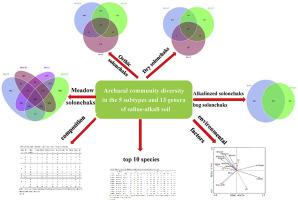Journal of Bioscience and Bioengineering ( IF 2.3 ) Pub Date : 2020-07-15 , DOI: 10.1016/j.jbiosc.2020.06.001 Lili Nan 1 , Quanen Guo 2 , Shiyu Cao 3

|
High-throughput sequencing was used to investigate the archaeal community structure and diversity, and associated influencing factors in the 5 subtypes and 13 genera of saline-alkali soil in Gansu Province, China. The results indicated the analysis of chemical parameters demonstrated statistically significant differences in these soils. Operational taxonomic units (OTUs), Chao 1, ACE, Simpson, and Shannon indexes of the archaeal community varied significantly in the 5 subtypes and 12 genera of soil except for chloride-type orthic solonchaks. The abundance was highest for sulfate-chloride-type meadow solonchaks and lowest for chloride-sulfate-type dry solonchaks. The diversity was highest for chloride-sulfate-type orthic solonchaks and lowest for sulfate-type orthic solonchaks. The archaeal community was dominated by the Euryarchaeota and Crenarchaeota. Except chloride-type orthic solonchaks; Halomicrobium in chloride-type meadow solonchaks (12.7%); Halobacterium in sulfate-chloride-type and chloride-sulfate-type dry solonchaks (11.1% and 9.2%, respectively); Candidatus Nitrososphaera in sulfate-chloride-type, chloride-sulfate-type, and sulphate-type meadow solonchaks; sulfate-type orthic solonchaks; and chloride bog solonchaks (9.0%, 21.6%, 27.0%, 45.3%, and 30.0%, respectively); Halorhabdus in sulfate-chloride-type orthic solonchaks, magnesium alkalized solonchaks, chloride-type dry solonchaks (15.7%, 11.5%, and 5.9%, respectively); and Haloarcula in chloride-sulfate-type orthic solonchaks (8.1%) were the most dominant archaea. Redundancy analysis showed that archaeal diversity was influenced by soil organic matter, total salt, sulfate anion, and zinc contents and pH. These results will lead to more comprehensive understanding of how 5 subtypes and 13 soil genera of saline-alkali soil affects microbial distribution.
中文翻译:

西北干旱区不同类型盐碱土古细菌群落多样性
采用高通量测序技术研究了甘肃省盐碱地土壤的5个亚型和13属的古细菌群落结构和多样性及其影响因素。结果表明,化学参数的分析证明了这些土壤的统计学差异。在5种亚型和12属土壤中,古细菌群落的操作分类单位(OTUs),Chao 1,ACE,Simpson和Shannon指数除氯型矫正的独角兽外均显着不同。硫酸盐-氯化物型草甸独角兽的丰度最高,而氯化物-硫酸盐型干独角兽的丰度最低。氯化物-硫酸盐型正统独奏的多样性最高,而硫酸盐型正统独奏的多样性最低。古细菌群落以Euryarchaeota和Crenarchaeota为主。除了氯化物型矫正的独角兽;Halomicrobium在氯化物型草地盐土(12.7%); 嗜盐在硫酸盐氯化物型和氯化物硫酸盐型干盐土(分别为11.1%和9.2%,); 暂定Nitrososphaera在硫酸盐氯化物型,氯化物硫酸盐型,和硫酸盐型草地盐土; 硫酸盐型矫形器;以及氯化物沼泽独木舟(分别为9.0%,21.6%,27.0%,45.3%和30.0%);Halorhabdus在硫酸盐氯化物型黄土正常盐土,镁碱化盐土,氯化物型干式盐土(分别为15.7%,11.5%和5.9%,); 和Halooccula氯化物-硫酸盐型矫形独角兽(8.1%)是最主要的古细菌。冗余分析表明古细菌的多样性受土壤有机质,总盐,硫酸根阴离子,锌含量和pH的影响。这些结果将使人们更全面地了解盐碱土壤的5个亚型和13个土壤属如何影响微生物的分布。











































 京公网安备 11010802027423号
京公网安备 11010802027423号